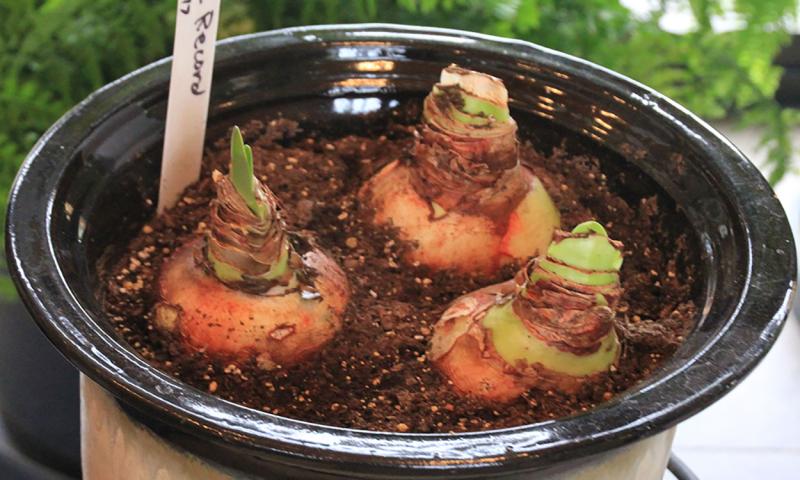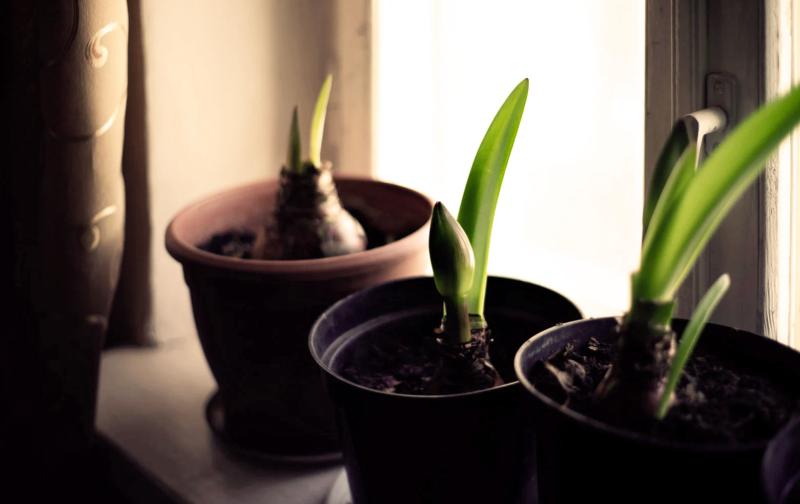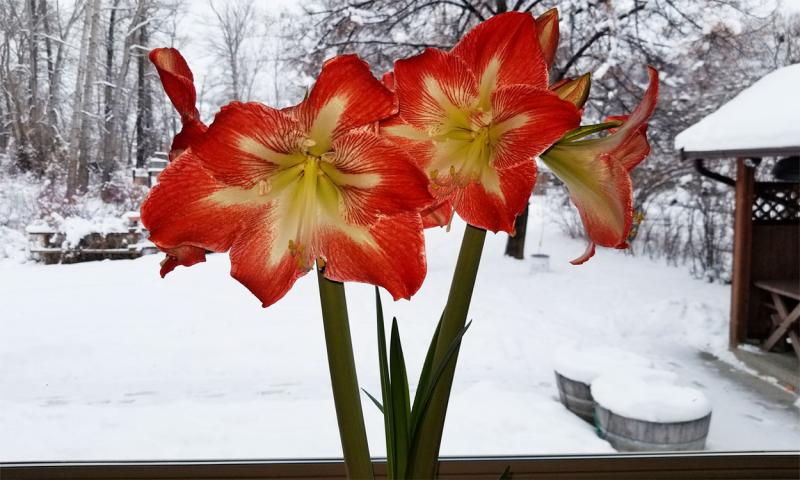
Written by Cindy Schnabel, South Dakota State University (SDSU) Extension Horticulture Assistant and Master Gardener, under the direction and review of Kristine Lang, SDSU Assistant Professor and Consumer Horticulture Extension Specialist.
Exploring the shelves of retails centers, you may notice boxes containing large bulbs lining the shelves. Sometimes these boxes may already be starting to open due to flower stalks and leaves starting to emerge. More than likely, you’ve found the seasonal display of amaryllis. These bulbs have already been exposed to a period of cool temperatures and are ready to emerge from dormancy that will result in large, bell-shaped floral displays. These beautiful, flowering bulbs are easy to grow to brighten up your home during the dark days of winter. This article offers some tips for purchasing and caring for amaryllis.
Purchasing Amaryllis

You will find amaryllis bulbs sold as described previously, but you may also find potted amaryllis with emerged foliage, flower stalks and perhaps even blooms also available. Select bulbs versus potted plants based on your sense of urgency for a display of color.
If you are purchasing bulbs, you’ll want to ensure that the bulbs appear healthy. Look in the box to see if the bulb has a bud tip starting. Check to see that it does not have any mold, fungus or soft spots. The larger the bulb, the more flower stalks it can produce.
Planting Amaryllis Bulbs

When you get the bulb home, find a heavy pot. It should have a wide base that is approximately two inches wider than the bulb. These plants have long stems with large flowers, so a heavier pot versus a light, plastic one will prevent the top-heavy amaryllis from tipping over when in full bloom.
Use a standard potting soil that can be purchased from most retail centers. Do not use garden soil, it is too heavy for the bulb to grow well. Prior to planting your bulbs, moisten the soil slightly. Fill the bottom half or your pot with soil, set your amaryllis bulb in the soil, and add more potting soil until you can only see the top third of the bulb. Always place the pointed end of the bulb up. If you decide to plant more than one bulb per pot, allow one inch of space between the bulbs. Keep a stake on hand to help give the plant support once it begins to grow.
After planting, water the potting soil well, which ensures the soil will settle around the bulb, removing large pockets of air. Until leaves emerge, the amaryllis will not require large amounts of water. Overwatering the bulb can lead to issues with disease and rotting. Once two or more inches of new growth appear, begin to water more frequently.
Amaryllis Care Prior to Flowering

Place the container in a location that is around 70 to 75 degrees Fahrenheit until leaves, stalks and roots form. Amaryllis perform well in bright light, which can come from south, east or west-facing windows in the winter. Usually, the first thing to emerge will be the bud, and leaves and additional stems will follow. Rotating the pot will make the stalk stronger and stand straighter, as the foliage may grow towards the light source.
It may take six to eight weeks for open flowers to appear from freshly potted amaryllis bulbs. Some varieties may take as long as 10 weeks to start flowering. Most amaryllis flower stalks contain four flowers each. The number of flower stalks will depend upon the variety and the size of the bulb. Larger bulbs that have a circumference of 12.5 inches or greater may produce four to five flower stalks per bulb. To achieve a succession of blooms, plant different varieties and plant them at different times.
Caring for Your Blooming Amaryllis

Once the amaryllis begins to flower, placing the plant in a cooler location will prolong bloom-time. An ideal temperature would be near 65 degrees Fahrenheit. Bright light will still be necessary; however, moving the plant out of indirect light may result in cooler temperatures throughout the day.
The average bloom time for amaryllis is two to three weeks. Once flower blooms start to fade and wrinkle, the blooms can be cut off with scissors. Once all flowers on a stalk have died back, the stalk can be cut off at the base of the plant. If you plan to keep your amaryllis for future blooms, let the leaves remain on the plant for several weeks so that the bulb can receive and store enough energy for future flower production.
References and Additional Resources
- Graper, David. 2019. Forcing Tender Bulbs Indoors. SDSU Extension, Brookings, South Dakota.
- Nau, J., B. Calkins, and A. Westbrook. 2021. Ball Redbook Volume 2: Crop Culture and Production (19th ed). Ball Publishing, West Chicago, Illinois.


